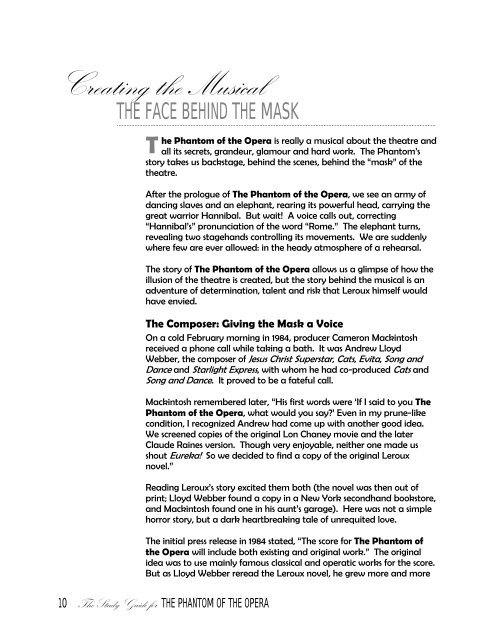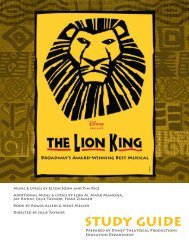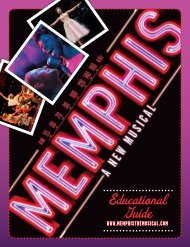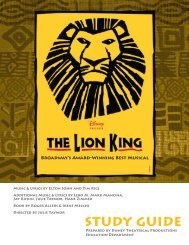Cameron Mackintosh And The Really Useful Theatre ... - Telecharge
Cameron Mackintosh And The Really Useful Theatre ... - Telecharge
Cameron Mackintosh And The Really Useful Theatre ... - Telecharge
You also want an ePaper? Increase the reach of your titles
YUMPU automatically turns print PDFs into web optimized ePapers that Google loves.
Creating the Musical<br />
THE FACE BEHIND THE MASK<br />
.......................................................................................................................................................................................................<br />
T<br />
he Phantom of the Opera is really a musical about the theatre and<br />
all its secrets, grandeur, glamour and hard work. <strong>The</strong> Phantom’s<br />
story takes us backstage, behind the scenes, behind the “mask” of the<br />
theatre.<br />
After the prologue of <strong>The</strong> Phantom of the Opera, we see an army of<br />
dancing slaves and an elephant, rearing its powerful head, carrying the<br />
great warrior Hannibal. But wait! A voice calls out, correcting<br />
“Hannibal’s” pronunciation of the word “Rome.” <strong>The</strong> elephant turns,<br />
revealing two stagehands controlling its movements. We are suddenly<br />
where few are ever allowed: in the heady atmosphere of a rehearsal.<br />
<strong>The</strong> story of <strong>The</strong> Phantom of the Opera allows us a glimpse of how the<br />
illusion of the theatre is created, but the story behind the musical is an<br />
adventure of determination, talent and risk that Leroux himself would<br />
have envied.<br />
<strong>The</strong> Composer: Giving the Mask a Voice<br />
On a cold February morning in 1984, producer <strong>Cameron</strong> <strong>Mackintosh</strong><br />
received a phone call while taking a bath. It was <strong>And</strong>rew Lloyd<br />
Webber, the composer of Jesus Christ Superstar, Cats, Evita, Song and<br />
Dance and Starlight Express, with whom he had co-produced Cats and<br />
Song and Dance. It proved to be a fateful call.<br />
<strong>Mackintosh</strong> remembered later, “His first words were ‘If I said to you <strong>The</strong><br />
Phantom of the Opera, what would you say?’ Even in my prune-like<br />
condition, I recognized <strong>And</strong>rew had come up with another good idea.<br />
We screened copies of the original Lon Chaney movie and the later<br />
Claude Raines version. Though very enjoyable, neither one made us<br />
shout Eureka! So we decided to find a copy of the original Leroux<br />
novel.”<br />
Reading Leroux’s story excited them both (the novel was then out of<br />
print; Lloyd Webber found a copy in a New York secondhand bookstore,<br />
and <strong>Mackintosh</strong> found one in his aunt’s garage). Here was not a simple<br />
horror story, but a dark heartbreaking tale of unrequited love.<br />
<strong>The</strong> initial press release in 1984 stated, “<strong>The</strong> score for <strong>The</strong> Phantom of<br />
the Opera will include both existing and original work.” <strong>The</strong> original<br />
idea was to use mainly famous classical and operatic works for the score.<br />
But as Lloyd Webber reread the Leroux novel, he grew more and more<br />
10 <strong>The</strong> Study Guide for THE PHANTOM OF THE OPERA





